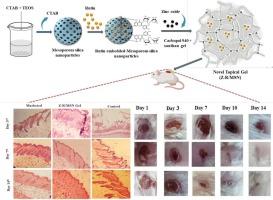芦丁/ZnO/介孔硅基纳米水凝胶通过潜在的协同生物活性反应加速白化小鼠局部伤口愈合。
IF 4.3
2区 医学
Q1 PHARMACOLOGY & PHARMACY
European Journal of Pharmaceutics and Biopharmaceutics
Pub Date : 2025-09-25
DOI:10.1016/j.ejpb.2025.114875
引用次数: 0
摘要
烧伤是意外局部伤害的主要原因。为了避免延迟愈合和微生物浸润的机会,用有效的抗菌和抗炎局部配方治疗伤口是强制性的。优化后的Z-R/MSN凝胶是用负载芦丁的介孔二氧化硅纳米颗粒和氧化锌的新型混合物制备的,使用Design Expert软件来增强局部伤口愈合。芦丁- zno分子配合物的硅分子对接与催化环的氨基酸残基LYS183和DFG基序的氨基酸ASP200形成h键相互作用,键距为3.01 Å ~ 3.32 Å。此外,与ASP133、TYR134和ASN186的疏水相互作用导致了酶活性的显著抑制,g值为-8.7 kcal/mol。与空白凝胶(60.67 %±0.06)相比,局部应用Z-R/MSN凝胶在白化小鼠模型上的伤口收缩(98.35 %±0.03)显著。区域的抑制表现出Z-R / MSN spp。克雷伯氏菌,金黄色葡萄球菌,铜绿假单胞菌、大肠杆菌和29.21 mm ± 2.39,29.27 毫米 ± 1.83,29.69 毫米 ± 2.68,和33.14 mm ±2.23 ,分别。本研究证明,Z-R/MSN凝胶可促进局部创面愈合,并对创面提供强大的抗菌保护。对这一创新配方的进一步研究可能会扩大其在临床皮肤科的商业应用。本文章由计算机程序翻译,如有差异,请以英文原文为准。

Rutin/ZnO/mesoporous Silica-based Nano-hydrogel accelerated topical wound healing in albino mice via potential synergistic bioactive response
Burn wounds are the leading cause of accidental topical injuries. To avoid the chances of delayed healing and microbial infiltration, treating the wound with a potent antimicrobial and anti-inflammatory topical formulation is mandatory. The optimized Z-R/MSN gel was fabricated using a novel blend of rutin-loaded mesoporous silica nanoparticles and zinc oxide, using Design Expert software to augment topical wound healing. The in silico molecular docking of Rutin-ZnO molecular complex presented H-bonding interactions with amino acid residues LYS183 of the catalytic loop and amino acid ASP200 of the DFG motif, with a bond distance ranging from 3.01 Å to 3.32 Å. Moreover, the hydrophobic interactions with ASP133, TYR134, and ASN186 contributed to the significant inhibition of enzyme activity with a G-score of −8.7 kcal/mol. Topical application of Z-R/MSN gel has shown significant wound contraction (98.35 % ± 0.03) in albino mice models compared to blank gel (60.67 % ± 0.06). Zones of inhibition exhibited by Z-R/MSN for Klebsiella spp., S. aureus, P. aeruginosa, and E. coli were 29.21 mm ± 2.39, 29.27 mm ± 1.83, 29.69 mm ± 2.68, and 33.14 mm ± 2.23, respectively. This research proved that Z-R/MSN gel accelerated topical wound-healing and provided robust antimicrobial protection to the wound. Further investigations on this innovative formulation may expand its commercial applications in clinical dermatology.
求助全文
通过发布文献求助,成功后即可免费获取论文全文。
去求助
来源期刊
CiteScore
8.80
自引率
4.10%
发文量
211
审稿时长
36 days
期刊介绍:
The European Journal of Pharmaceutics and Biopharmaceutics provides a medium for the publication of novel, innovative and hypothesis-driven research from the areas of Pharmaceutics and Biopharmaceutics.
Topics covered include for example:
Design and development of drug delivery systems for pharmaceuticals and biopharmaceuticals (small molecules, proteins, nucleic acids)
Aspects of manufacturing process design
Biomedical aspects of drug product design
Strategies and formulations for controlled drug transport across biological barriers
Physicochemical aspects of drug product development
Novel excipients for drug product design
Drug delivery and controlled release systems for systemic and local applications
Nanomaterials for therapeutic and diagnostic purposes
Advanced therapy medicinal products
Medical devices supporting a distinct pharmacological effect.

 求助内容:
求助内容: 应助结果提醒方式:
应助结果提醒方式:


